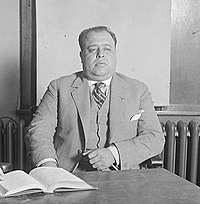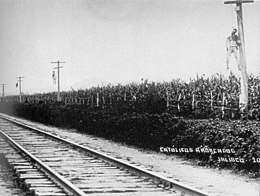Plutarco Elías Calles
Plutarco Elías Calles (25 September 1877 – 19 October 1945) was a Mexican military general and politician. He was the powerful interior minister under President Álvaro Obregón, who chose Calles as his successor. The 1924 Calles presidential campaign was the first populist presidential campaign in Mexico's history, as he called for land redistribution and promised equal justice, more education, additional labour rights, and democratic governance.
Plutarco Elías Calles | |
|---|---|
.jpg) | |
| 40th President of Mexico | |
| In office 1 December 1924 – 30 November 1928 | |
| Preceded by | Álvaro Obregón |
| Succeeded by | Emilio Portes Gil |
| Personal details | |
| Born | 25 September 1877 Guaymas, Sonora, Mexico |
| Died | 19 October 1945 (aged 68) Mexico City, D.F., Mexico |
| Political party | National Revolutionary Party Laborist Party (until 1929) |
| Spouse(s) | Natalia Chacón Amarillas
( m. 1899; died 1927)Leonor Llorente
( m. 1930; died 1932) |
| Parents |
|
| Military service | |
| Allegiance | |
| Branch/service | |
| Years of service | 1914–1920 |
After Calles' populist phase (1924–1926) he ushered in a state atheism phase (1926-1928). After leaving office he continued to be the dominant leader from 1928 to 1935, a period known as the Maximato, after a title Calles awarded to himself, Jefe Máximo (Maximum Chief) of the Revolution.
Calles is most noted for his implementation of anticlerical laws in the Mexican constitution. This led to the Cristero War, a civil war involving Catholics opposed to the administration. Calles also founded the Institutional Revolutionary Party in 1929. The party had ensured political stability in the wake of the assassination of president-elect Alvaro Obregón in 1928. In its two subsequent incarnations, it held power continuously from 1929 to 2000.
Early life and career
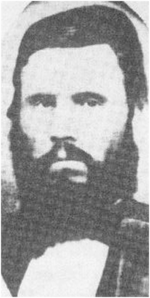
Francisco Plutarco Elías Campuzano one of two natural children of his alcoholic bureaucrat father, Plutarco Elías Lucero, and his mother María Jesús Campuzano Noriega. He adopted the Calles surname from his mother's sister's husband, Juan Bautista Calles, who with his wife María Josefa Campuzano raised him after the death of his mother.[1] His uncle was from a family of school teachers, but himself was a small-scale dealer in groceries and alcoholic beverages.[2] Plutarco's uncle was an atheist, and he instilled in his nephew a strong commitment to secular education and an attitude of disdain toward the Roman Catholic Church. This was later reflected in his social agenda, which included expansion of public education, and the removal of church influence from education, politics and unions.[3]
Plutarco's father's family was descended from a prominent family in the Provincias Internas, most often recorded as Elías González. The first of this line to settle in Mexico was Francisco Elías González (1707–1790), who emigrated from La Rioja, Spain, to Zacatecas, Mexico, in 1729. Eventually, he moved north to Chihuahua, where, as commander of the presidio of Terrenate, he played a role in the wars against the Yaqui and Apache. Plutarco Elías Calles's father, Plutarco Elías Lucero, lost his father in 1865, José Juan Elías Pérez, to battle wounds in the resistance to the French Intervention, leaving his widow with eight children, of which Plutarco was the oldest.[4] The family's fortunes declined precipitously; it lost or sold much of its land, some of it to the Cananea Copper Company, whose labor practices resulted in a major strike at the turn of the twentieth century.[4]
Calles became a committed anticlerical; some scholars attribute this to his social status as a natural or "illegitimate" child. "To society at large, Plutarco Elías Calles was illegitimate because his parents never married, but he was even more so in the eyes of religion. Denying the authority of religion would at least in part be an attempt to negate his own illegitimacy."[5]
As a young man, Calles worked in many different jobs, from bartender to schoolteacher, and always had an affinity for political opportunities.[6] Calles was an atheist.[7][8]
Before the presidency
Participation in the Mexican Revolution, 1910-17
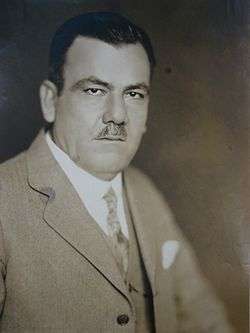
Calles was a supporter of Francisco I. Madero, under whom he became a police commissioner, and his ability to align himself with the Constitutionalists led by Venustiano Carranza, the political winners of the Mexican Revolution (1910–1920) allowed him to move up the ranks quickly; he attained the rank of general in 1915. He led the Constitutional Army in his home state of Sonora. In 1915, his forces repelled the Conventionalist faction there under José María Maytorena and Pancho Villa in the Battle of Agua Prieta.[9]
Governor of Sonora
Calles was elected as governor of his home state of Sonora, building a pragmatic political record. In 1915, Calles became governor of Sonora, known as one of the most reformist politicians of his generation. His radical rhetoric tended to conceal the pragmatic essence of his policy, which was to promote the rapid growth of the Mexican national economy, whose infrastructure he helped to establish. In particular, he attempted to make Sonora a dry state (a state in which alcohol is heavily regulated),[9] promoted legislation giving social security and collective bargaining to workers, and expelled all Catholic priests.
Service in the Carranza administration
In 1919, Calles travelled to Mexico City to take up the post of Secretary of Industry, Commerce, and Labor in the government of President Venustiano Carranza, the leader of the Constitutionalist faction that had won the Mexican Revolution. Calles’s position put him in charge of the Mexican economy, which had been devastated by the fighting during the civil war. Two main sources of production, mining and agriculture, had been severely affected by the fighting. The key infrastructure of Mexican railways, which had linked many cities and production sites in Mexico to the national market and to the United States, had been damaged. The national currency in Mexico had been replaced by paper money issued by revolutionary factions without backing by specie, so that U.S. paper dollars circulated. The lack of currency meant that in agriculture there was no incentive to produce for the market, so there were food shortages. Malnourished populations were more vulnerable to disease, and Mexico experienced the influenza pandemic of 1918. Although Calles was in the halls of power, Carranza appears to have brought him to Mexico to put him in a holding pattern with no impact on Carranza’s policies, but more aimed at dividing the triumvirate of Sonora generals, Alvaro Obregón, Adolfo de la Huerta, and Calles himself. Calles did gain political experience in his months serving in Carranza’s government, and his attempt to settle a labor dispute in Orizaba gained him the support of workers there.[10]
Revolt of the Sonoran generals, 1920
In 1920, he aligned himself with fellow Sonoran revolutionary generals Adolfo de la Huerta and Álvaro Obregón to overthrow Carranza under the Plan of Agua Prieta. Carranza had attempted to impose an unknown civilian, Ignacio Bonillas, the Mexican ambassador to the U.S. and his successor. Carranza was forced out of power, and died escaping, De la Huerta became interim president. De la Huerta named Calles to the important post of Minister of War.[11]
Obregón administration, De la Huerta revolt, election of 1924
Obregón was elected president in 1920 and he named Calles as Secretary of the Interior.[12] During the Obregón presidency (1920–24) Calles aligned himself with organized labor, particularly the Regional Confederation of Mexican Workers (CROM), headed by Luis N. Morones and the Laborist Party, as well as agraristas, radical agrarians. In 1923, Obregón tapped Calles to be his successor in the presidency, but Adolfo de la Huerta and others in the Mexican army opposed to Calles as the presidential choice revolted.
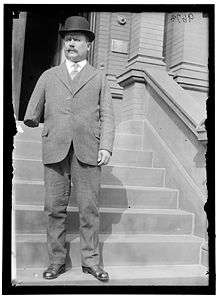
The serious military conflict was resolved in favor of Obregón when the U.S. threw its support to him. Obregón's government had acceded to concessions to U.S. business interests, particularly oil, in the August 1923 Bucareli Treaty. Obregón pushed through ratification in the Mexican congress, and the U.S. then moved decisively. President Calvin Coolidge sent naval ships to blockade the Gulf Coast to prevent the rebels from obtaining arms and to deliver arms to Obregón's government. Obregón went to war once again and won a decisive victory against his former comrades-in-arms, 14 of whom were summarily executed. Obregón's support of Calles for the presidency was sealed by force of arms against those opposing his choice. That steely resolve set the precedent that the incumbent's choice of successor "had to be accepted by the 'revolutionary family'" or be crushed.[13]
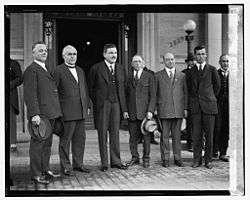
Calles's candidacy was supported by labor and peasant unions. The Laborist Party which supported his government in reality functioned as the political-electoral branch of the powerful Regional Confederation of Mexican Workers (CROM), led by Luis N. Morones. Morones had a national reputation as a labor leader and had forged an alliance with Samuel Gompers, head of the American Federation of Labor, a moderate craft union organization. In 1916 Gompers and Morones put pressure on the Mexican and U.S. governments, which were heading toward war. In Mexico, Morones was credited with aiding the withdrawal of U.S. troops in Mexico sent by U.S. President Woodrow Wilson. CROM's support for Calles was important for his election.[14] Although the labor movement in Mexico was factionalized, CROM was a staunch supporter of Obregón and Calles.
In 1924, following these events, "Calles won the pre-arranged elections before the eyes of an indifferent nation."[15] He defeated the agrarianist candidate Ángel Flores and the eccentric perennial candidate Nicolás Zúñiga y Miranda.
Shortly before his inauguration, Calles had traveled to Germany and France to study social democracy and the labor movement, and he drew comparisons to Mexico. His international travel gave him a perspective beyond the Mexican context. He particularly admired the infrastructure and industry in Germany, as well as strides that a strong organized labor movement had made. He also observed the power of populist rhetoric to build support, and early in his presidency such rhetoric served him to distance himself from Obregón.[16]
Presidency, 1924–1928
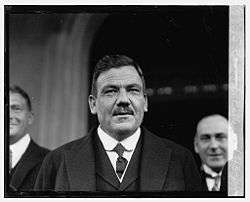
Calles's inauguration was a great state occasion, with some 50,000 spectators: his predecessor Obregón was present for the first peaceful transfer of presidential power since 1884, when Porfirio Díaz succeeded Manuel González. Workers from the CROM, headed by Luis Morones, and the Laborist Party of Mexico displayed banners. Balloons and release of doves figured in the spectacle. The De la Huerta rebellion had thinned the ranks of the military.[17]
Although Calles was president, he remained in the shadow of the powerful Obregón, who had powerful allies in the military and among state governors and the Congress. The contrast between Calles and Obregón was of personality and level of power. "To many, Calles appeared Obregón's creation, a caretaker president who would return power to the caudillo upon the conclusion of his term." Calles sought to build his own power base. He launched a reform program that was modeled on the one in Sonora to promote economic development, professionalize the army, promote social and educational welfare. He relied on worker and peasant organizations to support his consolidation of power, particularly Luis N. Morones of the CROM.[18]
Labor
Morones was appointed to a cabinet position as Secretary of Industry, Commerce and Labor at the same time that he retained leadership in the CROM. In that position Morones was able to advance his organization at the expense of rivals'. Some independent unions and more radical were forced into the umbrella of the moderate CROM. Wage increases and betterment of working conditions were evidence that Calles sought to implement Article 123 of the Mexican Constitution, embedding labor rights. The number of labor strikes decreased precipitously in the Calles administration. When railway workers struck in 1926, Morones sent scabs to break the strike.[19]
Finance
During the Calles presidency, he relied on the financial acumen of his Secretary of the Treasury, Alberto J. Pani, who was a loyalist of Obregón and served in his cabinet. Pani's classical liberal policies of a balanced budget and stable currency helped restore foreign investors' confidence in Mexico. Pani advised the founding of several banks in support of campesinos, but more importantly the Banco de México, Mexico's national bank. Pani also managed to achieve relief of part of Mexico's foreign debt. After coming into conflict with Calles, Pani resigned in 1927.[20][21][22][23]
Military
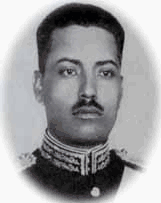
The military continued to be very top heavy with revolutionary generals and army was allocated a third of the national budget. Generals had participated in the De la Huerta rebellion in 1923, which cleared the way for Calles's candidacy. Obregón awarded loyalists following that revolt. The military continued to be a potential interventionist force in Mexican politics, with generals presuming that they could rise to the presidency. Calles sought to professionalize the army and decrease its share of the national budget, putting Joaquín Amaro in charge of implementing major changes. Many generals had achieved their status as battlefield promotions. The Calles administration called for a change in the law regulating the military, mandating that officers must have professional training to rise in rank. The administration also aimed at decreasing corruption by severely penalizing it. A further control was a mandatory retirement age for officers. The most powerful generals were not reined in by such provisions, but Amaro managed to get some cooperation with their enforcement of regulations on subordinates. The Colegio Militar was reformed under Amaro and remained a hope for improvement of officers in the future.[24]
Infrastructure
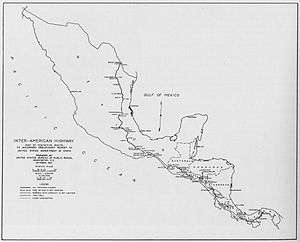
Since the Porfiriato, railroads had been important to economic development and exerting political control over more remote areas. Fighting during the Revolution damaged railways, so rebuilding had been on going since the end of the military phase. Calles privatized the railways and a line was built to establish a connection between Sonora, Calles's home state, and Mexico City.[25] Even more important during his presidency, Calles began what became a major infrastructure project to build a road network in Mexico that linked major cities as well as small villages to the network. He established the National Road Commission as a government agency, envisioning it as a way to increase economic activity by getting crops to market more efficiently, but also as means to increase the presence of the state in remote communities. Unlike the nineteenth-century railway network, funded by foreign capital and foreign firms, Mexican road construction depended on federal government support and had limited dependence on foreign technology. Mexicans formed road building companies, most prominently in northern Mexico with revolutionary general Juan Andreu Almazán, in 1920s charge of the military in Nuevo León, forming the Anáhuac Construction Company, making him a wealthy man. This extensive infrastructure project "connected the country, increasingly linking people from different regions and towns to national political, economic, and cultural life."[26] Work began on the Mexican section of the Pan American Highway, linking Nuevo Laredo at the U.S.-Mexico border to Tapachula on the Mexico-Guatemala border. Road building was financed internally with a gasoline tax.[25]
Education
Education had been an important part of Obregón's administration, particularly under José Vasconcelos. Calles was able to devote more government funding to rural education, added two thousand schools to the thousand that his predecessor had established. A key aim of rural education was to integrate Mexico's indigenous population into the nation-state, so Spanish-language instruction was an integral aspect of public education. Along with turning rural indigenous into Spanish speakers, the aim of education was to create a loyal and patriotic citizenry. Secretary of Education José Manuel Puig Cassauranc developed education materials lauding the accomplishments of Sonorans Obregón and Calles as heirs to the Revolution.[27] The Secretariat of Public Education, based in the capital and controlled by urban intellectuals, could not command rural residents and public school teachers to adhere to the program, so on site there was a kind of negotiation about how education was shaped.[28]
Public health
After the Revolution public health in Mexico was not in a good state, but it had not been particularly good even during the Porfiriato. The Calles administration sought to improve health and hygiene, since the health of citizens was considered important to economic development. He gave the issue prominence by creating a cabinet-level position of public health. The ministry was in charge of promoting vaccination against communicable diseases, improving potable water access, sewage and drainage systems, and inspecting restaurants, markets, and other food providers. A new 1926 sanitary code ordered mandatory vaccination and empowered the government to implement other measures for sanitation and hygiene.[29] Also part of the program was the mandatory registration of prostitutes.[30]
Civil law
Calles changed Mexico's civil code to give natural (illegitimate) children the same rights as those born of married parents, partly as a reaction against the problems he himself often had encountered being a child of unmarried parents. According to false rumors,[31] his parents had been Syrians or Turks, giving him the nickname El Turco (The Turk). His detractors drew comparisons between Calles and the "Grand Turk", the anti-Christian leaders from the era of the Crusades. In order not to draw too much attention to his unhappy childhood, Calles chose to ignore those rumors rather than to fight them.[32][33]
Another important legal innovation in Calles's presidency was the Law of Electrical Communications (1926), which asserted the radio airwaves as being under government regulation. Radio stations had to comply with government regulations, which included constraints on religious or political messages, But stations had to broadcast government announcements without cost. Although in the 1920s, there were relatively few people owning radios, nonetheless, the regulations were an important assertion of state power. During the Lázaro Cárdenas presidency (1934–40), state control over broadcasts expanded further.[34]
Petroleum and U.S.-Mexico relations
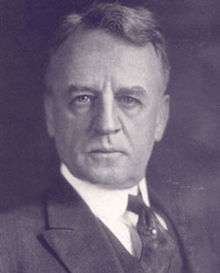
One of the major points of contention with the U.S. was oil. Calles quickly rejected the Bucareli Agreements of 1923 between the U.S. and Mexico, when Álvaro Obregón was president, and began drafting a new oil law that would strictly enforce article 27 of the Mexican constitution. The oil problem stemmed from article 27 of the Mexican Constitution of 1917, which re-stated a law from Spanish origin that made everything under the soil property of the state. The language of article 27 threatened the oil possession of U.S. and European oil companies, especially if the article was applied retroactively. A Mexican Supreme Court decision had ruled that foreign-owned fields could not be seized as long as they were already in operation before the constitution went into effect. The Bucareli Agreements stated that Mexico would agree to respect the Mexican Supreme Court decision in exchange for official recognition from Washington of the presidency of Álvaro Obregón.[35]
The reaction of the U.S. government to Calles's intention to enforce article 27 was swift. The American ambassador to Mexico branded Calles a communist, and Secretary of State Frank B. Kellogg issued a threat against Mexico on 12 June 1925.[36] Calles never considered himself a communist; he considered revolution a way of governing rather than an ideological position. Public opinion in the United States turned particularly anti-Mexican when the first embassy of the Soviet Union in any country was opened in Mexico, on which occasion the Soviet ambassador remarked that "no other two countries show more similarities than the Soviet Union and Mexico."[37] After this, some in the United States government, considering Calles's regime Bolshevik, started to refer to Mexico as "Soviet Mexico".[38]
The debate on the new oil law occurred in 1925, with U.S. interests opposing all initiatives. By 1926, the new law was enacted. In January 1927 the Mexican government canceled the permits of oil companies that would not comply with the law. Talks of war circulated by the U.S. president and in the editorial pages of the New York Times. Mexico managed to avoid war through a series of diplomatic maneuvers. Soon afterward, a direct telephone link was established between Calles and President Calvin Coolidge, and the U.S. ambassador to Mexico, James R. Sheffield, was replaced with Dwight Morrow. Morrow won the Calles government over to the United States position and helped negotiate an agreement between the government and the oil companies.[39]
Another source of conflict with the United States was Mexico's support for the liberals in the civil war in Nicaragua, as the United States supported the conservatives. This conflict ended when both countries signed a treaty in which they allowed each other to support the side they considered to be the most democratic.
Church-state conflict
Calles had implemented a number of reforms in the first two years of his presidency (1924–26) benefiting workers and peasants. In this he followed in the pattern of his predecessor, Obregón. However, in the second two years of his presidency and into his post-presidency, Calles precipitated a major conflict between the Mexican government, the Roman Catholic Church in Mexico as an institution, and Mexican Catholics. Calles was a staunch anticlerical from Sonora, a region of Mexico where the Catholic Church was less strong than the center and south of Mexico.
During his term as president, he moved to enforce the anticlerical articles of the Constitution of 1917, which led to a violent and lengthy conflict known as the Cristero Rebellion or the Cristero War, which was characterized by reprisals and counter-reprisals. The Mexican government violently persecuted the clergy, massacring suspected Cristeros and their supporters. The conflict ended in 1929 with the mediation of the U.S. Ambassador to Mexico, Dwight Morrow with the Mexican government and the Vatican.
On 14 June 1926, President Calles enacted anticlerical legislation known formally as The Law Reforming the Penal Code and unofficially as the Calles Law.[40] Calles's anti-Catholic actions included outlawing religious orders, depriving the Church of property rights and depriving the clergy of civil liberties, including their right to trial by jury (in cases involving anti-clerical laws) and the right to vote.[40][41] Catholic antipathy towards Calles was enhanced because of his vociferous anti-Catholicism.[42] In response to the government enforcement of anticlerical laws, the Catholic Church called for a clerical strike, which entailed ceasing to celebrate Mass, baptize children, sanctify marriage, and perform rituals for the dead. The clerical strike went on for three years.
Due to Calles's strict and sometimes violent enforcement of anti-clerical laws, people in strongly Catholic areas, especially the states of Jalisco, Zacatecas, Guanajuato, Colima and Michoacán, began to oppose him, and on 1 January 1927, a war cry went up from the faithful Catholics, "¡Viva Cristo Rey!", long live Christ the King!
Almost 100,000 people on both sides died in the war.[43] A truce was negotiated with the assistance of U.S. Ambassador Dwight Morrow in which the Cristeros agreed to lay down their arms.[44] However, Calles reneged on the terms of the truce within a few months; he had approximately five hundred Cristero leaders and 5,000 other Cristeros shot, frequently in their homes in front of their wives and children.[44] Particularly offensive to Catholics after the truce was Calles's insistence on a complete state monopoly on education, suppressing all Catholic education and introducing "socialist" education in its place, saying: "We must enter and take possession of the mind of childhood, the mind of youth."[44] The persecution continued as Calles maintained control under his Maximato and did not relent until 1940, when President Manuel Ávila Camacho, a practicing Catholic, took office.[44]
The effects of Calles's policy on the Church were profound. Between 1926 and 1934, at least 4,000 priests were killed or expelled; one of the most famous was the Jesuit Miguel Pro.[44] Where there had been 4,500 priests in Mexico prior to the rebellion, in 1934 there were only 334 priests licensed by the government to serve fifteen million people, the rest having been eliminated by emigration, expulsion, execution and assassination.[44][45] By 1935, seventeen states had no priests at all.[46]
Economically, the Cristero War had an adverse impact on Mexico, with grain production greatly reduced in the region of the Bajío, where fighting was fierce. Government resources were diverted to the military conflict rather than into reform programs for workers and peasants. The conflict weakened Calles politically, and that weakness paved the way for Alvaro Obregón to return to the presidency in the 1928 election.[47]
1928 Election
Obregón ran unopposed in the 1928 presidential election. He was able to stand as a candidate, despite his having served as president before. Under Calles's administration in 1926, a constitutional change was passed that allowed for a non-consecutive re-election,[48] and in 1928 Obregón was elected as Calles's successor; this amendment was later repealed in 1934.[49] In addition, Mexico passed an amendment to the constitution in 1927 that expanded a presidential term from four years to six years.[50]
Post Presidency
Founding a new party and the Maximato 1929-34
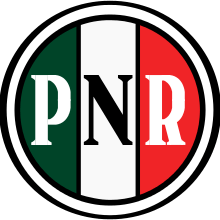
.svg.png)
President-elect Obregón was murdered by José de León Toral, a Catholic militant, before he could assume power. Calles was ineligible to return to the presidency, but he took steps to avoid a political vacuum. Emilio Portes Gil was appointed temporary president, while Calles created a new political party, the National Revolutionary Party (Spanish: Partido Nacional Revolucionario, PNR), the predecessor of today's Institutional Revolutionary Party (Spanish: Partido Revolucionario Institucional, PRI).
The period that Obregón had been elected to serve, between 1928 and 1934, was when Calles became the Jefe Máximo, the "maximum chief," and the power behind the presidency. It was a title he never used for himself. The period is known as the Maximato (1928–1934), with many regarding Emilio Portes Gil, Pascual Ortiz Rubio, and Abelardo Rodríguez as puppets of Calles. Officially, after 1929, Calles served as minister of war, as he continued to suppress the Cristero War, but a few months later, after intervention of the United States ambassador Dwight Morrow, the Mexican government and the Cristeros signed a peace treaty. During the Maximato, Calles became increasingly authoritarian and would also serve as Minister of Industry and Commerce.[51] In the early 1930s, he appears to have flirted with the idea of implementing aspects of fascism in the government,[52] and the ideology clearly had an influence on him.[53]
After a large demonstration in 1930, the Mexican Communist Party was banned, Mexico stopped its support for the rebels of César Sandino in Nicaragua, strikes were no longer tolerated, and the government ceased re-distributing lands to poorer peasants. Calles had once been the candidate of the workers and at one point had used Communist unions in his campaign against competing labor organizers, but later, having acquired wealth and engaging in finance, suppressed Communism.[54]
By the summer of 1933, two of Calles's former wartime subordinates had risen to the top of the party: Manuel Pérez Treviño and Lázaro Cárdenas.[55] Calles sought to have Treviño be the party's nominee at the time, seeing that he would be the most likely to continue his policies,[55] but soon yielded to pressure from party officials and agreed to support Cárdenas—a former revolutionary general, governor of Michoacán, and popular land reformer—as the PNR's presidential candidate in the 1934 Mexican Presidential election.[55] By this time, the PNR had become so entrenched that Cárdenas' victory was a foregone conclusion; he won with almost 98 percent of the vote.
End of the Maximato and exile
Cárdenas had been associated with Calles for over two decades; he had joined Calles's army in Sonora in 1915.[55] For that reason, Calles and his allies trusted Cárdenas, and Calles believed he could control Cárdenas as he had controlled his predecessors.[55] However, Cárdenas soon revealed himself as an independent. Indeed, conflicts between Calles and Cárdenas started to arise not long after Cárdenas was sworn in. Calles opposed Cárdenas's support for labor unions, especially his tolerance and support for strikes, while Cárdenas opposed Calles's violent methods and his closeness to fascist organizations, most notably the Gold Shirts of general Nicolás Rodríguez Carrasco, which harassed Communists, Jews and Chinese.[56]
Cárdenas started to isolate Calles politically, removing the callistas from political posts and exiling many of his political allies: Tomás Garrido Canabal, Fauto Topete, Emilio Portes Gil, Saturnino Cedillo, Aarón Sáenz, Nicolás Rodríguez Carrasco, Pascual Ortiz Rubio and finally Calles himself. Calles and head of the labor organization CROM, Luis N. Morones, one of the last remaining influential callistas and one-time Minister of Agriculture,[51] were charged with conspiring to blow up a railroad and placed under arrest under the order of President Cárdenas. Calles was deported to the United States on April 9, 1936 along with the three last highly-influential callistas in Mexico—Morones: Luis León (leader of the Radical Civic Union in Mexico),[57] and General Rafael Melchor Ortega (one-time Governor of Guanajuato). His son Alfredo and his secretary were also exiled.[51] At the time of his arrest, Calles was reportedly reading a Spanish translation of Mein Kampf; a political cartoon of the era depicts this.[58][59]
In exile in the United States, Calles was in contact with various U.S. fascists, although he rejected their anti-Semitic[60] and anti-Mexican sentiments, and also befriended José Vasconcelos, the Mexican philosopher who had previously been a political enemy.
Return from exile and final years
With the Institutional Revolutionary Party now firmly in control and in the spirit of national unity, President Manuel Ávila Camacho (1940–46) allowed Calles to return to Mexico under the reconciliation policy of Cárdenas's successor in 1941. He spent his last years quietly in Mexico City and Cuernavaca.[61]
Back in Mexico, Calles's political position became more moderate; in 1942, he supported Mexico's declaration of war upon the Axis powers. In his last years, he reportedly became interested in spiritualism.[62]
Personal life
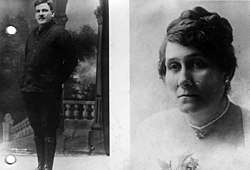
Calles married Natalia Chacón (1879–1927) and the marriage produced 12 children. Rodolfo Elías Calles (1900–1965), governor of Sonora 1931–34; Plutarco Elías Calles Chacón("Aco"), (1901–1976), governor of Nuevo León 1929; Berndardina (died in infancy); Natalia (1904–1998); Hortensia ("Tencha") (1905–1996); Ernestina ("Tinina") (1906–1984); Elodia (1908), died in infancy; María Josefina (1910), died in infancy; Alicia (1911–1988); Alfredo (1913–1988); Artemisa (1915–1998); and Gustavo (1918–1990).[63] After his first wife's death in 1927, he married a young woman from Yucatan, Leonor Llorente, who died of a brain tumor in 1932 at age 29.[64][65] Calles's own health was not good over his lifetime, and in his later years deteriorated. His problems date from the winter of 1915 when he came down with a rheumatic ailment, likely from extended periods outdoors in sub-freezing temperatures. He also experienced stomach problems and insomnia. The death of his wife Natalia in 1927 was a severe blow personally. Although he remarried in 1930, his second wife Leonor died soon afterwards. Grief and ill health appear to have distracted him from political involvement.[66]
Legacies
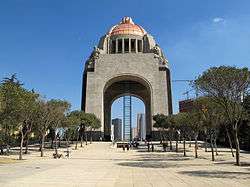
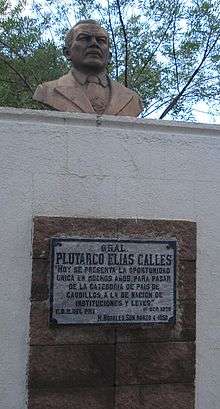
Calles's main legacy was the pacification of Mexico ending the violent era of the Mexican Revolution through the creation of the Partido Nacional Revolucionario (PNR), which became Partido Revolucionario Institucional (PRI), which governed Mexico until 2000 and returned to power for one term in the elections of 2012.
Calles's legacy remains controversial today, but within the PRI it has undergone a reappraisal. His remains were moved from their original resting place to be interred in the Monument to the Revolution, joining other major figures, Madero, along with Carranza, Villa, and Cárdenas who in life were his foes. For many years, the presidency of Cárdenas was touted as the revival of the ideals of the Revolution, but increasingly the importance of Calles as the founder of the party that brought political stability to Mexico has been recognized. When the son of Lázaro Cárdenas broke with the PRI in 1988, the party leadership began to burnish Calles's reputation as the party's founder. In 1990, a monument to Calles was erected that commemorated his September 1928 speech declaring the end of the age of caudillos. His speech was made in the aftermath of Obregón's assassination and as the political solution to violence at presidential successions was being resolved by the party he brought into being.[67]
He is honored with statues in Sonoyta, Hermosillo, and his hometown of Guaymas. The official name of the municipality of Sonoyta is called Plutarco Elías Calles Municipality in his honor.
For his fierce anti-clericalism, Calles was denounced by Pope Pius XI (r. 1922-1939) in the encyclical Iniquis afflictisque (On the Persecution of the Church in Mexico) as being "unjust", for a "hateful" attitude and for the "ferocity" of the war which he waged against the Church.[68]
References
- Krauze, Enrique. Mexico: Biography of Power. New York: HarperCollins 1997, pp. 404-405.
- Krauze, Mexico, p. 405.
- Gonzales, Michael J. The Mexican Revolution, 1910–1940, p. 203-204, UNM Press, 2002.
- Krauze, Mexico, p. 404.
- Krauze, Mexico: Biography of Power, p. 406, citing Macías Richard, Gerardo. Vida y temperamento de Plutarco Elías Calles 1877-1920. Mexico 1995, pp. 71-72.
- Gonzales, Michael J. The Mexican Revolution, 1910–1940. University of New Mexico Press. Albuquerque, 2002. Page 203.
- Gonzales, Michael J., The Mexican Revolution, 1910–1940, p. 268, UNM Press, 2002
- Shirk, David A. Mexico's New Politics: The PAN and Democratic Change p. 58 (L. Rienner Publishers 2005)
- Stacy, Lee. Mexico and the United States. Marshall Cavendish Corporation. Tarrytown, New York, 2002. Page 124.
- Buchanau, Jürgen, Plutarco Elías Calles and the Mexican Revolution. Lanham: Rowman and Littlefield Publishers Inc.2007, pp. 83-87
- John Womack, Jr. "The Mexican Revolution" in Mexico Since Independence, Leslie Bethell, ed. New York: Cambridge University Press 1991, p. 195-96.
- Womack, "The Mexican Revolution", p. 200
- Meyer, "Mexico in the 1920s", p. 210.
- Buford, Nick. "A Biography of Luis N. Morones", PhD dissertation, Louisiana State University 1971, p. 20
- Meyer, Jean, "Mexico in the 1920" in Mexico Since Independence, Leslie Bethell, ed. New York: Cambridge University Press 1991, pp. 206-07.
- Buchenau, Plutarco Elías Calles, pp. 111-12
- Buchenau, Plutarco Elías Calles, pp. 112-13
- Buchenau, Plutarco Elías Calles, p. 115
- Buchenau, Plutarco Elías Calles, pp. 115-16.
- Roderic Ai Camp, "Alberto Pani Arteaga" in Encyclopedia of Latin American History and Culture, vol. 4, p. 286. New York: Charles Scribner’s Sons 1996.
- Keith A. Haynes, "Order and Progress: The Revolutionary Ideology of Alberto J. Pani." PhD. Diss. Northern Illinois University 1981.
- Meyer, "Mexico in the 1920s" pp. 219-20.
- Cristina Puga, "Alberto Pani" in Encyclopedia of Mexico, vol. 2, pp. 1046-48. Chicago: Fitzroy Dearborn 1997.
- Buchenau, Plutarco Elías Calles, pp. 120-21
- Buchenau, Plutarco Elías Calles, p. 121.
- Waters, Wendy. "Remapping Identities: Road Construction and Nation Building in Postrevolutionary Mexico" in The Eagle and the Virgin: Nation and Cultural Revolution in Mexico, 1920-1940. Mary Kay Vaughan and Stephen E. Lewis, eds. Durham: Duke University Press 2006, p. 224.
- Buchenau, Plutarco Elías Calles, p. 123
- Vaughan, Mary Kay. Cultural Politics and the Revolutioin: Teachers, Peasants, and Schools in Mexico, 1930-1940. Tucson: University of Arizona Press 1998, pp. 3-30.
- Soto Laveaga, Gabriela and Claudia Agostoni, "Science and Public Health in the Century of Revolution" in A Companion to Mexican History and Culture, Ed. William H. Beezley. Blackwell, 2011, p. 567
- Bliss, Katherine E.Compromised Positions: Prostitution, Public Health, and Gender Politics in Revolutionary Mexico City. University Park: Penn State Press 2001, pp. 1-5
- Krauze, Enrique. Mexico: Biography of Power. A History of Modern Mexico, 1810–1996. HarperCollins Publishers Inc. New York, 1997. Page 412.
- Krauze, Mexico: Biography of Power, p. 413.
- Medina-Navascues, Tere. Plutarco Elías Campuzano, mal conocido como presidente Calles. HarperCollins Publishers Inc. New York, 1997. Pages 9–11.
- Joy Elizabeth Hays, "National Imaginings on the Air: Radio in Mexico, 1920-1940" in The Eagle and the Virgin: Nation and Cultural Revolution in Mexico, 1920-1940. Mary Kay Vaughan and Stephen E. Lewis, eds. Durham: Duke University Press 2006, pp. 243-258
- Kirkwood, Burton. The history of Mexico. Greenwood Press, Westport, 2000. Pages 157–158.
- Krauze, Enrique. Mexico: Biography of Power. A History of Modern Mexico, 1810–1996. HarperCollins Publishers Inc. New York, 1997. Page 417.
- Krauze, Enrique. Mexico: biography of power : a history of modern Mexico, 1810–1996, p. 418, Harper Collins 1998.
- Richards, Michael D. Revolutions in World History, p. 30 (2004, Routledge), ISBN 0-415-22497-7.
- Krauze, Enrique. Mexico: Biography of Power. A History of Modern Mexico, 1810–1996. HarperCollins Publishers Inc. New York, 1997. Pages 417–419.
- Joes, Anthony James. Resisting Rebellion: The History and Politics of Counterinsurgency, p. 70 (2006 University Press of Kentucky), ISBN 0-8131-9170-X.
- Tuck, Jim. "THE CRISTERO REBELLION – PART 1", Mexico Connect, 1996.
- Shirk, David A. (2005). Mexico's New Politics. Lynne Rienner Publishers. ISBN 1-58826-270-7.
- Young, Julia G. (July 2013). "The Calles Government and Catholic Dissidents: Mexico's Transnational Projects of Repression, 1926-1929". The Americas. The Academy of American Franciscan History. 70: 69 in pages 63–91. doi:10.1353/tam.2013.0058.
- Van Hove, Brian (1994). "Blood-Drenched Altars". Faith & Reason. Eternal Word Television Network.
- Scheina, Robert L. (2003). Latin America's Wars: The Age of the Caudillo, 1791–1899. Brassey's. p. 33. ISBN 1-57488-452-2.
- Ruiz, Ramón Eduardo (1993). Triumphs and Tragedy: A History of the Mexican People. W. W. Norton & Company. p. 393. ISBN 0-393-31066-3.
- Buchenau, Plutarco Elías Calles, p. 207.
- Mexico: an encyclopedia of contemporary culture and history, Coerver, Don M. and Suzanne B. Pasztor, pg. 55.
- "Mexico - President". Globalsecurity.org. Retrieved 5 January 2019.
- "Archived copy". Archived from the original on 2013-03-13. Retrieved 2019-01-06.CS1 maint: archived copy as title (link)
- "MEXICO: Solution Without Blood". Time. 20 April 1936.
- Payne, Stanley (1996). A History of Fascism. Routledge. ISBN 1-85728-595-6. p. 342.
- Blamires, Cyprian and Jackson, Paul, World fascism: a historical encyclopedia, Volume 1, p. 148, ABC CLIO 2006.
- Calles, Plutarco Elias, Columbia Encyclopedia, Sixth Edition. 2001–05 Archived 2008-05-16 at the Wayback Machine
- "Jahrbuch für Geschichte Lateinamerikas / Anuario de Historia de América Latina". Jbla.de. Retrieved 5 January 2019.
- Meyer, Michael C. and Sherman, William L. The Course of Mexican History (5th E. Oxford Univ. Press 1995).
- "Falleció Luís León". Diario26.com. Retrieved 5 January 2019.
- Krauze, Enrique. Mexico: Biography of Power p. 436.
- Larralde, Carlos. "Roberto Galvan: A Latino Leader of the 1940s". The Journal of San Diego History 52.3/4 (Summer/Fall 2006) p. 160.
- Stavans, Ilan. "El exilio incómodo: México y los refugiados judíos by Daniela Gleizer." The Americas 69.4 (2013): 529-530.
- Krauze, Mexico, p. 436.
- Larralde, Carlos. Roberto Galvan: A Latino Leader of the 1940s.
- Buchenau, Plutarco Elías Calles, p. 94
- Quirós Martínez, Roberto. Leonor Llorente de Elías Calles. Mexico City 1933
- ["El segundo aire de los presidentes" https://www.cunadegrillos.com/2016/10/04/el-segundo-aire-de-los-presidentes]
- Buchenau, Plutarco Elias Calles, p. 162
- Buchenau, Plutarco Elías Calles, pp. 201-02
- Iniquis afflictisque, 12, 15, 19–20.
Further reading
| Wikimedia Commons has media related to Plutarco Elías Calles. |
- Aguilar Camín, Héctor. "The Relevant Tradition: Sonoran Leaders in the Revolution." in Caudillo and Peasant in the Mexican Revolution. D. A. Brading, ed. Cambridge: Cambridge University Press 1980.
- Brown, Lyle C. "The Calles-Cárdenas Connection." in Twentieth-Century Mexico. W. Dirk Raat and William H. Beezley, ed. Lincoln: University of Nebraska Press 1986, pp. 146–58.
- Buchenau, Jürgen. Plutarco Elias Calles and the Mexican Revolution (Denver: Rowman & Littlefield, 2006). ISBN 978-0-7425-3749-1
- Buchenau, Jürgen. Calles y el movimiento liberal en Nicaragua. Boletín 9. Mexico: Fideicomiso Archivos Plutarco ElíasCalles y Fernando Torreblanca 1992.
- Castro Martínez, Pedro. De la Buerta y Calles: Los límites políticos de la amistad, Boletín 23. Mexico City: FAPEC 1996.
- Dulles, John W.F. Yesterday in Mexico: A Chronicle of the Revolution, 1919-1936. Austin: University of Texas Press 1961.
- Horn, James. "El embajador Sheffield contra el presidente Calles." Historia Mexicana 20, no. 2 (oct 1970): 265-84.
- José Valenzuela, Georgette E. La campaña presidencial de 1923-1924 en México, Mexico City: Instituto Nacional de Estudios Históricos de la Revolución Mexicana, 1998.
- José Valenzuela, Georgette E. El relevo del caudillo: De cómo y por qué Calles fue candidato presidencial. Mexico City: El Caballito 1982.
- José Valenzuela, Georgette E. "El viaje de Plutarco Elías Calles como president electo por Europa y Estados Unidos." Revista Mexicana de Sociología 57, no. 3 (1995): 191-210.
- Krauze, Enrique, Mexico: Biography of Power. New York: HarperCollins 1997. ISBN 0-06-016325-9
- Krauze, Enrique. Reformar desde el origen: Plutarco Elias Calles. Mexico City: Fondo de Cultura Económica 1987.
- Kubli, Luciano. Calles y su gobierno: Ensayo biográfico. Mexico City 1931.
- Loyo Camacho, Martha Beatriz. Plutarco Elias Calles desde su exilio. Boletín 45. Mexico City: Archivo Fideicomiso Plutarco Elias Calles y Fernando Torreblanca 2004.
- Lucas, Jeffrey Kent. The Rightward Drift of Mexico's Former Revolutionaries: The Case of Antonio Díaz Soto y Gama. Lewiston, New York: Edwin Mellen Press, 2010.
External links
- Mexico Before the World by Plutarco Elías Calles at archive.org
- El General, film on P.O.V. on PBS (US) co-presented by Latino Public Broadcasting; July 20, 2010. Filmmaker Natalia Almada works from audio recordings made by her grandmother about Calles, Almada's great-grandfather, relating history to present in Mexico.
- Newspaper clippings about Plutarco Elías Calles in the 20th Century Press Archives of the ZBW
| Political offices | ||
|---|---|---|
| Preceded by Álvaro Obregón |
President of Mexico 1924–1928 |
Succeeded by Emilio Portes Gil |
| Awards and achievements | ||
| Preceded by Chauncey M. Depew |
Cover of Time Magazine 8 December 1924 |
Succeeded by Dwight F. Davis |
